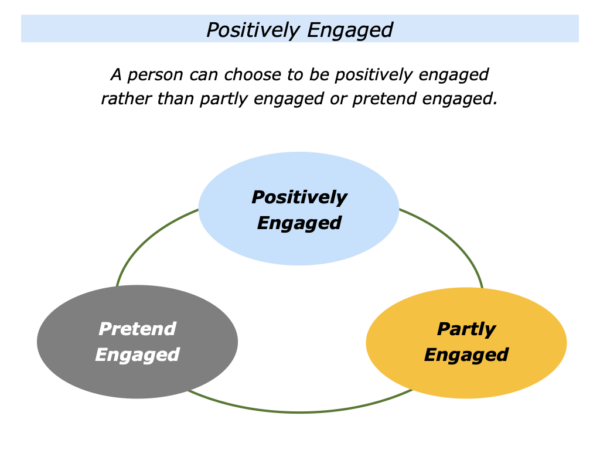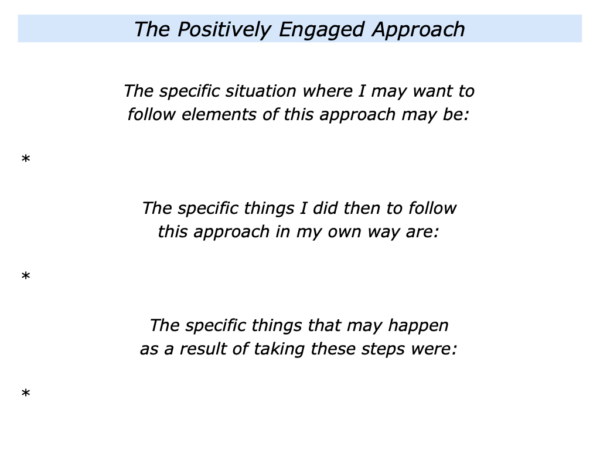
People often do their best work when they are positively engaged rather than partly engaged or pretend engaged. This sounds obvious but it can be important to recognise your different levels of engagement. Let’s explore these themes.
Positively Engaged
What are the activities in which you feel positively engaged? Different people give different answers to this question. Here are some of the things they mention.
I feel positively engaged when I am:
Encouraging certain kinds of people … Playing the piano … Cooking nutritious food … Working in my garden … Doing interior design … Solving technical problems … Working in the hospice.
What do you do right when you are positively engaged? You may aim to prepare properly. Moving into action, you may feel alive and alert. You may then use your whole being to focus fully on the situation and work towards the desired picture of success.
Let’s assume you have begun to focus on where you are positively engaged. It may also be useful to recognise another experience.
Partly Engaged
When do you feel partly engaged? Sometimes you are interested, sometimes you are not. The feeling is:
“I could be spending my time doing something more worthwhile.”
How do you behave then? What are the consequences – for you and for other people – when you behave this way? Let’s explore some of your options.
You can try to avoid putting yourself into situations where you feel partly engaged but sometimes this can be difficult. Bearing this in mind, how can you manage the situation?
One approach is to plan ahead and decide how you want to behave in the situation. If appropriate, it is to ask yourself:
How can I be professional? How can I play a positive role and support other people? How can I make a positive contribution in the situation?
This can work for a while. But you will need to prepare properly and rehearse how you will behave in the situation. Sometimes you may need to buy time and not react to triggers that can send you into a negative spiral.
Pretend Engaged
What are the activities in which you feel pretend engaged? You may feel uncomfortable, unreal and must make a real effort to appear professional.
Something bugs you. Maybe it is the values of the people or the company. Maybe you don’t believe in what they are doing.
Nevertheless, you summon-up energy to do your best. But afterwards you may get headaches or other symptoms. Continually putting yourself in these situations can have consequences for your health.
Being Positively
Engaged In The Future
Imagine that you want to focus on the activities where you feel positively engaged. Taking this step sometimes required planning. One manager described how they tackled this challenge.
“Looking back at my work pattern, I found that I felt positively engaged only 20% of the time. This was having an effect on both my personal and professional life. Looking to the future, I decided to do three things.
“First, to list the activities in which I felt positively engaged. These included selling to certain kinds of customers. Second, to spend more time doing these things. Third, to show the business case for doing these things by getting some quick wins.
“This approach proved successful. I began to put together the high points like a string of pearls across the week. Within six months I was spending 80% of my week doing stimulating work that brought benefits to the company.
“There are still some meetings where I feel partly engaged, but I try to be professional and make a positive contribution. I feel much happier in both my personal and professional life.”
Let’s return to your own life and work. Looking ahead, how can you put yourself into more of the situations where you feel positively engaged? What may be the be the benefits– both for yourself and other people?
If you wish, try tackling the exercise on this theme. This invites you to complete the following sentences.



Leave a Reply